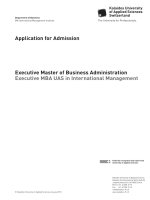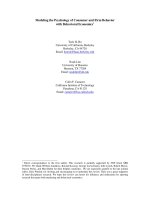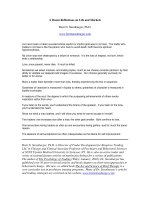Psychology of selling summary Personal MBA
Bạn đang xem bản rút gọn của tài liệu. Xem và tải ngay bản đầy đủ của tài liệu tại đây (149.37 KB, 21 trang )
Chapter 2
The Psychology of
Selling:
Why People Buy,
What People Buy
© 2001 McGraw-Hill Ryerson Ltd.
All rights reserved.
2-1
Stimulus-Response Model of Buyer
Behaviour
Sales Presentation
Stimulus
Stimulus
© 2001 McGraw-Hill Ryerson Ltd.
Buyer’s Hidden
Mental Process
Black Box
Sales/No Sale
Response
Response
All rights reserved.
2-2
Why People Buy
Needs - basic requirements for human life (must have)
Wants - discretionary items (would like to have)
© 2001 McGraw-Hill Ryerson Ltd.
All rights reserved.
2-3
Needs Analysis
Diagnose the buyer’s situation
before prescribing a solution.
© 2001 McGraw-Hill Ryerson Ltd.
All rights reserved.
2-4
Conducting Needs Analysis
1.
2.
3.
4.
5.
6.
7.
Explain why you conduct needs analysis
Use open-ended probes
Focus on what results the buyer is seeking
Use the Reverse Ripple technique (general to specific)
Use the SPIN technique
Ask “smart” questions
Summarize
© 2001 McGraw-Hill Ryerson Ltd.
All rights reserved.
2-5
Examples of Features
(tangible and intangible characteristics)
1.
2.
3.
4.
5.
6.
Nationally advertised consumer product
Air conditioner with a high energy efficiency rating
Product made of stainless steel
Supermarket computer system with the IBM 3651 Store Controller
Five percent interest on money in bank checking NOW account
Golf clubhead aerodynamically designed titanium steel
© 2001 McGraw-Hill Ryerson Ltd.
All rights reserved.
2-6
1.
2.
3.
4.
5.
6.
Examples of Advantages
(performance characteristics)
Will sell more product
Uses less electricity
Will not rust
Can store more information and retrieve it rapidly by supervising up
to 24 grocery checkout scanners and terminals and look up prices on
up to 22,000 items
Earns interest that would not normally be received
Increased clubhead speed, longer drives
© 2001 McGraw-Hill Ryerson Ltd.
All rights reserved.
2-7
Examples of Benefits
(favourable results)
1.
2.
3.
4.
Will make you a high profit
Saves 10 percent in energy costs
Reduces your replacement costs
Provides greater accuracy, register balancing, store ordering, and
inventory management
Gives you one extra bag of groceries each month
Lower scores
5.
6.
© 2001 McGraw-Hill Ryerson Ltd.
All rights reserved.
2-8
Matching Buyer Needs to Product Benefits
and Emphasizing Them in a Sales Presentation
Important
Important
Seller
Seller
(emphasize)
(emphasize)
Benefits
Benefits
Unimportant
Unimportant
© 2001 McGraw-Hill Ryerson Ltd.
Important
Important
Needs
Needs
(deemphasize)
(deemphasize)
Buyer
Buyer
Unimportant
Unimportant
All rights reserved.
2-9
Trial Closes
(feedback questions)
1.
2.
3.
4.
5.
6.
What do you think of our money-back guarantee?
Is this level of quality what you had in mind?
How does our delivery schedule sound to you?
Can you see how our marker will save you time and money?
Do you think your employees will find our software easy to use?
What is your impression of the range of colours we offer?
© 2001 McGraw-Hill Ryerson Ltd.
All rights reserved.
2-10
The SELL Sequence
SS
EE
LL
LL
feature
feature
advantage
advantage
into
intobenefit
benefit
customer
customertalk
talk
SShow
how
EExplain
xplain
© 2001 McGraw-Hill Ryerson Ltd.
LLead
ead
LLetet
All rights reserved.
2-11
Guidelines to Identifying Personality Style
Guideline
! How to describe this person
! The person’s strengths
! The person’s drawbacks
! Time orientation
Environment
! Room
Personality Style
! Thinker
! Intuitor
! Feeler
! Senser
! Desk
! Dress
© 2001 McGraw-Hill Ryerson Ltd.
All rights reserved.
2-12
Guideline: How to describe this person
! Thinker: A direct, detail-oriented person. Likes to deal in sequence
on his/her time. Very precise, sometimes seen as a nit-picker. Fact
oriented.
! Intuitor: A knowledgeable, future-oriented person. An innovator who
likes to abstract principles from a mass of material. Active in
community affairs by assisting in policy making, program
development, etc.
! Feeler:
People-oriented. Very sensitive to people’s needs. An
emotional person rooted in the past. Enjoys contact with people.
Able to read people very well.
! Senser:
Action-oriented person. Deals with the world through his/her
senses. Very decisive and has a high energy level.
© 2001 McGraw-Hill Ryerson Ltd.
All rights reserved.
2-13
Guideline: The person’s strengths
! Thinker: Effective communicator, deliberative, prudent, weighs
alternatives, stabilizing, objective, rational, analytical, asks
questions for more facts.
! Intuitor: Original, imaginative, creative, broad-gauged, charismatic,
idealist, intellectual, tenacious, ideological, conceptual, involved.
! Feeler:
Spontaneous, persuasive, emphatic, grasps, traditional values,
probing, introspective, draws out feelings of others, loyal, actions
based on what has worked in the past.
! Senser:
Pragmatic, assertive, directional results-oriented, technically
skillful, objective—bases opinions on what he/she actually sees,
perfection-seeking, decisive, direct and down to earth,
action-oriented.
© 2001 McGraw-Hill Ryerson Ltd.
All rights reserved.
2-14
Guideline: The person’s drawbacks
! Thinker: Verbose, indecisive, overcautious, overanalyzes, unemotional,
nondynamic, controlled and controlling, overserious, rigid,
nit-picking.
! Intuitor: Unrealistic, far-out, fantasy-bound, scattered, devious, out-of-
touch, dogmatic, impractical, poor listener.
! Feeler:
Impulsive, manipulative, overpersonalizes, sentimental,
postponing, guilt-ridden, stirs up conflict, subjective.
! Senser:
Impatient, doesn’t see long-range, status-seeking, selfinvolved, acts first then thinks, lacks trust in others, nit-picking,
impulsive, does not delegate to others.
© 2001 McGraw-Hill Ryerson Ltd.
All rights reserved.
2-15
Guideline: Time orientation
! Thinker: Past, present, future
! Intuitor: Future
! Feeler:
Past
! Senser:
Present
© 2001 McGraw-Hill Ryerson Ltd.
All rights reserved.
2-16
Environment: Desk
! Thinker: Usually neat
! Intuitor: Reference books, theory books, etc.
! Feeler:
Personal plaques and mementos, family pictures
! Senser:
Chaos
© 2001 McGraw-Hill Ryerson Ltd.
All rights reserved.
2-17
Environment: Room
! Thinker: Usually has a calculator and computer runs, etc.
! Intuitor: Abstract art, bookcases, trend charts, etc.
! Feeler:
Decorated warmly with pictures of scenes or people.
Antiques.
! Senser:
Usually a mess with piles of papers, etc. Action pictures or
pictures of the manufacturing plant or products on the wall.
© 2001 McGraw-Hill Ryerson Ltd.
All rights reserved.
2-18
Environment: Dress
! Thinker: Neat and conservative.
! Intuitor: Mod or rumpled.
! Feeler:
Current styles or informal.
! Senser:
No jacket; loose tie or functional work clothes.
© 2001 McGraw-Hill Ryerson Ltd.
All rights reserved.
2-19
Personal, Psychological, and Social Forces
That Influence Buying Behavior
Personal
PersonalInfluences
Influences
Income
Income
Age
Age
Gender
Gender
Situation
Situation
Psychological
PsychologicalInfluences
Influences
Past
Pastexperiences
experiences
Personality
Personality
Attitudes
Attitudesand
andbeliefs
beliefs
Perception
Perception
Social
SocialInfluences
Influences
Culture
Culture
Social
Socialclass
class
Friends
Friends
Family
Family
Consumer buying decision process
Need
arousal
Collection of
information
© 2001 McGraw-Hill Ryerson Ltd.
Information
evaluation
Purchase
decision
Postpurchase
behavior
All rights reserved.
2-20
The Three Classes of Buying
Situations
Low involvement
Routine
Routine
decision
decision
making
making
© 2001 McGraw-Hill Ryerson Ltd.
High involvement
Limited
Limited
decision
decision
making
making
Extensive
Extensive
decision
decision
making
making
All rights reserved.









